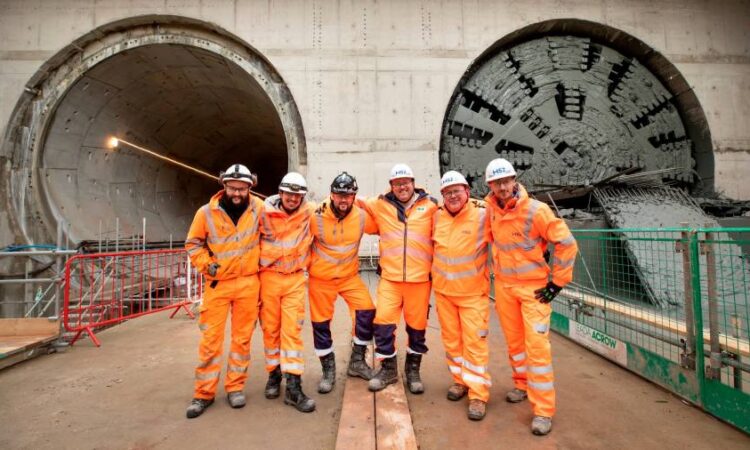
Under cloudy skies in Warwickshire last month, a 2,000-tonne boring machine nicknamed “Dorothy” tore through a concrete wall to complete the first in a series of tunnels that will eventually carry high-speed trains under the English countryside.
The breakthrough moment provided a much-needed boost for HS2, the controversial high-speed rail project that was originally envisaged to connect London to Manchester and Leeds via Birmingham by 2033.
But successive delays and cost overruns have meant that the scope has been cut back and completion is still as long as two decades away.
Dorothy has been tunnelling on part of the first phase that was originally due to open between central London and Birmingham in 2026. But that part of the line is running at least three years late, while the budget for what remains of the entire project could exceed £70bn, up from £37.5bn in 2013.
HS2 has divided opinion since it was first unveiled in 2010 as a way to add extra capacity to the country’s ageing railway network and speed up journey times between its biggest cities. And the debate about whether the project is worth building has only intensified with constraints on public spending showing no sign of easing.
As ministers sought to reduce the ballooning costs in recent years, the project shrunk. An eastern leg, that was due to run to Sheffield into Leeds from Birmingham and would have vastly improved connectivity between three of the UK’s biggest cities, was all but axed last year.
In the most recent changes announced last month, the government delayed plans to run the trains into the central London terminus at Euston until as late as the early 2040s. The cost of completing Euston is now put at nearly £5bn.

That decision has only fuelled criticism and provided further ammunition to those who believe the government should scrap the entire project.
At the time, transport secretary Mark Harper blamed the latest delays on the “headwinds from inflation” caused by Russia’s invasion of Ukraine as well as “supply chain disruption” owing to the Covid-19 pandemic.
Andrew Gilligan, who was transport adviser to Boris Johnson when the then-prime minister axed the eastern leg, has argued the ballooning budget meant HS2 costs more to build than the value of the benefits it would deliver. He rejected the claim that it would create 500,000 new jobs as an “absurd exaggeration” and argued that public support for the project was low “everywhere”.

In contrast, the project’s backers argue the existing network desperately needs the extra capacity.
Rail executives and engineers said the successive reviews, redesigns and scope reductions ordered by ministers to try to control the costs have had the opposite effect.
“If the government was not lukewarm on the project and there was a genuine thrust to build it then it would be progressing to its original timescales and not far off its original budget,” said Gareth Dennis, a railway engineer and industry writer.
The cuts have angered many civic and business leaders across the north of England who support the project.
Henri Murison, chief executive of the Northern Powerhouse Partnership lobby group, said the government had “mismanaged” it. “All they have done is make the value for money worse,” he said.
Torsten Bell, chief executive of the Resolution Foundation, an influential think-tank, said HS2 underlined why the government needed a wider rethink on its “too low and too volatile” investments in infrastructure.
“Budgets are set but then tinkered with all too frequently. This impedes efforts to plan long-term infrastructure projects, such as HS2,” he said. “Big projects will always face stumbling blocks — but the state institutions responsible for overseeing them shouldn’t so consistently be one of them”.

One former Tory transport minister said it was the spiralling costs of the project that had left ministers with a conundrum.
“The problem is that once you’ve spent a certain amount of money it becomes even more difficult to back out of it, and that macro decision was taken a long time ago,” he said. “There seems to have been complacency in government that the original price would be the end price but that almost never happens with big capital projects, as we keep learning to our cost.”
It is difficult to quantify the economic impact of a project with high upfront costs and benefits that will be spread over several decades if not centuries.
A government assessment of the economic case early last decade found a line with branches both west to Manchester, and the since cancelled leg east to Leeds, would “most likely” provide “high” value for money, while the London to Birmingham link would be “medium” value.
Critics such as Gilligan have argued that analysis is now out of date given the cost overruns, and argued the money would be better spent on upgrading parts of the existing rail network.
Maria Machancoses, chief executive of Midlands Connect, a transport body that speaks for local authorities across the region, said the project remained “vital to our region’s economy”, and that business leaders were “basing their investment decisions on major infrastructure investment”.

Railway industry experts said no upgrades to the existing network could deliver the benefits of an entirely new line. They argue HS2 would help unlock a shift away from roads and on to rail, a critical part of decarbonising the transport industry which is responsible for nearly a quarter of the country’s carbon emissions.
The government said HS2 continued to “represent a crucial investment into our national infrastructure” and would help address regional economic disparities.
Industry executives hope the controversy will eventually be consigned to history, pointing to design life of the railway of more than 100 years.
“We all think it is a horrifically long time scale . . . but let’s stay calm here,” said one board member of the High Speed Rail Group. “Everybody knows they are building this for the next generation.”






